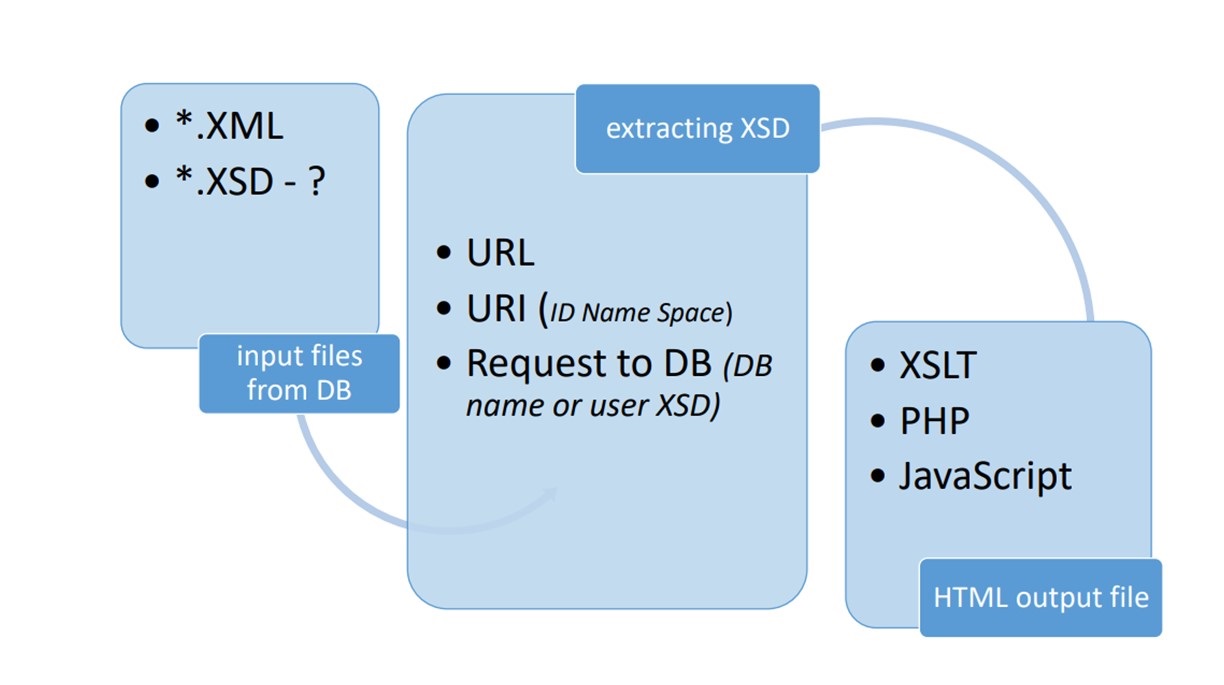Development of an adaptive graphic web interface model for editing XML data
DOI:
https://doi.org/10.15587/1729-4061.2023.276585Keywords:
web interfaces, XML document management/navigation, XML/XSLT transformation, non-well-formed dataAbstract
The ability of the end user to work with a large amount of data from a large number of heterogeneous sources and at the same time get an effective result from the work is carried out through the use of graphical web interfaces built on the basis of XML technologies that allow displaying any structure of a file presented in XML format. As a data exchange method between applications on the Web, XML still lacks capabilities for identification of web resources and a system that uses them, and capabilities to express the knowledge provided by XLM documents. In this study, a web interface has been developed (a web-based server application), as an XML records editor that provides display forms for the creation and editing of XML documents and is able to adapt to the internal resources of the system used. The technology is based on the XSD data set schema transformation by the way of XSLT transformations. Screen forms are generated on the server side and are provided to the user with all the necessary tools for correct input and/or editing of heterogeneous data. A distinguishing characteristic of this technology is the ability to display both properly and improperly formed XML data. The developed graphical interface allows any application to automatically exchange and read information from other applications without human intervention, which significantly improves performance and ease of use. This software solution could be used both as an independent data building and editing module presented in the XML format, and as a built-in module plugged into various server software for heterogeneous information management systems
References
- Brahmia, Z., Hamrouni, H., Bouaziz, R. (2020). XML data manipulation in conventional and temporal XML databases: A survey. Computer Science Review, 36, 100231. doi: https://doi.org/10.1016/j.cosrev.2020.100231
- Bajaj, A., Bick, W. (2020). The rise of NoSQL systems: Research and pedagogy. Journal of Database Management, 31 (3), 67–82. doi: https://doi.org/10.4018/JDM.2020070104
- Jounaidi, A., Bahaj, M. (2018). Converting of an xml schema to an owl ontology using a canonical data model. Journal of Theoretical and Applied Information Technology, 96 (5), 1422–1435. Available at: http://www.jatit.org/volumes/Vol96No5/24Vol96No5.pdf
- Nikiforov, D. A., Korj, D. V., Sivakov, R. L. (2017). An Approach to the Validation of XML Documents Based on the Model Driven Architecture and the Object Constraint Language. A.P. Ershov Informatics Conference. doi: http://dx.doi.org/10.13140/RG.2.2.16542.23364
- Tekli, G. (2021). A survey on semi-structured web data manipulations by non-expert users. Computer Science Review, 40, 100367. doi: https://doi.org/10.1016/j.cosrev.2021.100367
- Bao, L., Yang, J., Wu, C. Q., Qi, H., Zhang, X. Cai, S. (2022). XML2HBase: Storing and querying large collections of XML documents using a NoSQL database system. Journal of Parallel and Distributed Computing, 161, 83–99. doi: https://doi.org/10.1016/j.jpdc.2021.11.003
- Brahmia, Z., Grandi, F., Oliboni, B., Bouaziz, R. (2018). Supporting Structural Evolution of Data in Web-Based Systems via Schema Versioning in the tXSchema Framework. In Handbook of Research on Contemporary Perspectives on Web-Based Systems, 271–307. doi: https://doi.org/10.4018/978-1-5225-5384-7.ch013
- Brahmia, Z., Hamrouni, H., Bouaziz, R. (2022). TempoX: A disciplined approach for data management in multi-temporal and multi-schema-version XML databases. Journal of King Saud University - Computer and Information Sciences, 34 (1), 1472–1488. doi: https://doi.org/10.1016/j.jksuci.2019.08.009
- Engelfriet, J., Hoogeboom, H. J., Samwel, B. (2020). XML navigation and transformation by tree-walking automata and transducers with visible and invisible pebbles. Theoretical Computer Science, 850, 40–97. doi: https://doi.org/10.1016/j.tcs.2020.10.030
- Akazawa, G., Matsubara, N., Suzuki, N. (2022). An Algorithm for Transforming Property Path Query Based on Shape Expression Schema Update. SN Computer Science, 3, 196. doi: https://doi.org/10.1007/s42979-022-01086-0
- Mahmood, A. T., Kamil Naser, R., Khalil Abd, S. (2022). Privacy protection based distributed clustering with deep learning algorithm for distributed data mining. Eastern-European Journal of Enterprise Technologies, 4 (9 (118)), 48–58. doi: https://doi.org/10.15587/1729-4061.2022.263692
- Fan, C., Li, Z. (2019). Research on Addressing Method in XML File Based on XPointer. Advances in Graphic Communication, Printing and Packaging, 384–389. doi: https://doi.org/10.1007/978-981-13-3663-8_52

Downloads
Published
How to Cite
Issue
Section
License
Copyright (c) 2023 Aigul Mukhitova, Aigerim Yerimbetova, Lyailya Cherikbayeva

This work is licensed under a Creative Commons Attribution 4.0 International License.
The consolidation and conditions for the transfer of copyright (identification of authorship) is carried out in the License Agreement. In particular, the authors reserve the right to the authorship of their manuscript and transfer the first publication of this work to the journal under the terms of the Creative Commons CC BY license. At the same time, they have the right to conclude on their own additional agreements concerning the non-exclusive distribution of the work in the form in which it was published by this journal, but provided that the link to the first publication of the article in this journal is preserved.
A license agreement is a document in which the author warrants that he/she owns all copyright for the work (manuscript, article, etc.).
The authors, signing the License Agreement with TECHNOLOGY CENTER PC, have all rights to the further use of their work, provided that they link to our edition in which the work was published.
According to the terms of the License Agreement, the Publisher TECHNOLOGY CENTER PC does not take away your copyrights and receives permission from the authors to use and dissemination of the publication through the world's scientific resources (own electronic resources, scientometric databases, repositories, libraries, etc.).
In the absence of a signed License Agreement or in the absence of this agreement of identifiers allowing to identify the identity of the author, the editors have no right to work with the manuscript.
It is important to remember that there is another type of agreement between authors and publishers – when copyright is transferred from the authors to the publisher. In this case, the authors lose ownership of their work and may not use it in any way.









